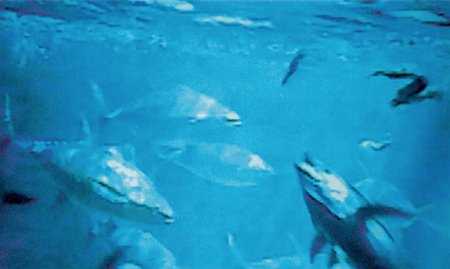
Yellowfin tuna aren’t just beautiful; they’re also incredibly adaptable, living in warm waters around the globe. But here’s the thing: their reproduction process is complex and needs specific conditions to be successful. Just like planting a garden requires the right soil and weather, yellowfin tuna need the right environment to reproduce effectively. In this article, we’ll explore how these amazing fish go about their breeding process, the conditions they need, and the challenges they face along the way.
Understanding Yellowfin Tuna Reproduction
Yellowfin tuna (Thunnus albacares) have a unique reproductive strategy that sets them apart from many other fish. They are ovarian spawners, meaning the females release their eggs into the water, where fertilization occurs externally. This process can sound a bit impersonal, but it works quite well in the vast oceanic environment.
During spawning season, which typically occurs from spring to late summer, the females can release thousands of eggs at a time. You might imagine them as tossing seeds into a wild ocean garden. This high egg count is crucial, as not all eggs will survive; in fact, many will become prey for other marine life. The survival rate is low, but by producing so many eggs, yellowfin tuna increase the chances of having enough offspring make it to adulthood.
Optimal Conditions for Spawning
The breeding of yellowfin tuna depends significantly on environmental factors. They prefer warm waters with temperatures between 24°C and 29°C (75°F to 84°F). Think of it like a cozy spot on a beach; when it gets chilly, you might want to stay inside. For yellowfin tuna, the right temperature ensures that their eggs develop properly.
Moreover, they often seek areas where the water is rich in nutrients, particularly upwellings or areas near the coast where ocean currents bring food. This nutrient-rich environment provides essential sustenance for the young tuna after they hatch. Without these optimal conditions, their chances of survival drop significantly, much like a plant needing both sunlight and water to thrive.
The Spawning Process
When the time is right, yellowfin tuna engage in a spectacular spawning ritual. Males and females gather in schools, often in shallow, warm waters. It’s almost like a dance party where everyone knows exactly when to show up! As females release eggs into the water, males swim alongside them to fertilize the eggs.
The entire process can happen quickly—often within a matter of hours. After fertilization, the eggs float to the surface, where they hatch within a couple of days. The young fish, called larvae, look nothing like their adult counterparts. They are tiny and vulnerable, drifting in the currents, searching for food to sustain their growth.
Challenges Faced During the Breeding Process
Despite their amazing reproductive strategies, yellowfin tuna face numerous challenges. Overfishing is a significant threat, as commercial fishing can drastically reduce their populations. When adult tuna are removed from the ecosystem, it disrupts the delicate balance that allows for successful breeding.
Additionally, environmental changes such as rising sea temperatures and ocean pollution can affect spawning habitats. If the water gets too warm, or if pollutants infiltrate their breeding grounds, the eggs might not survive. This situation is similar to a gardener trying to grow flowers in poor soil; no matter how hard you try, it just won’t work out.
The Role of Young Tuna in the Ecosystem
Once the yellowfin tuna larvae hatch, they drift in the currents, growing and developing in the open ocean. This phase is crucial for their future as adults. Young tuna will often school together, which provides some protection from predators. Here’s a fun fact: young tuna feed on tiny plankton and small fish, playing a vital role in the marine food web.
The growth rates for yellowfin tuna are impressive, as they can reach maturity in just a few years. This rapid growth is vital because it ensures that they can start reproducing relatively quickly. You might wonder how long they live; well, yellowfin tuna can live up to about 7 years, but they usually face many dangers in that time.
Conservation Efforts for Yellowfin Tuna
Conserving yellowfin tuna populations is essential for maintaining ecological balance and ensuring future generations can enjoy these beautiful fish. Organizations focused on marine conservation work diligently to implement sustainable fishing practices and protect spawning habitats.
One significant effort includes setting fishing quotas and protected marine areas where fishing is restricted during peak spawning seasons. By doing this, we’re essentially giving yellowfin tuna a safe space to reproduce, much like ensuring a bird sanctuary remains unbothered during nesting season.
The Future of Yellowfin Tuna Reproduction
The future of yellowfin tuna depends heavily on our actions today. Awareness about sustainable fishing practices is crucial, as it encourages responsible consumption and helps protect breeding populations. Additionally, scientists are studying ways to enhance tuna farming practices to relieve pressures on wild populations.
Looking ahead, education plays a vital role in ensuring the survival of yellowfin tuna. When more people understand these fish’s importance and challenges, they are more likely to advocate for protective measures. It’s all about working together to keep the soup of life in our oceans full of diverse and thriving species.
In closing, the breeding and reproduction of the yellowfin tuna is a complex yet fascinating process that highlights the intricate relationships within our oceans. By understanding these dynamics, we can better appreciate and protect these incredible creatures for generations to come. So next time you enjoy a tuna steak or see one swimming in the ocean, remember the journey it took to get there!
